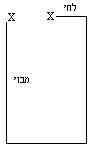
HIDE/SHOW IMAGE
7b
{Eruvin 26a continues}
except for water and salt.
One who vows {to refrain} from mazon is permitted water and salt.
We may make an eruv {chatzeirot} for a Nazir with wine, and for an Israelite with teruma.
Symmacus says: With Chullin and not with teruma.
And for a Cohen in a bet haPras1.
{Eruvin 27a}
Rabbi Yehuda says: Even in a cemetary, because he can (go) outside and eat.
Gemara:
Rabbi Yochanan said: We do not learn from general rules (klalot), even when they utilize the expression "except for."
Ravina, and some say Rav Nachman bar Yitzchak, said: We too, learned it {tanina}: With all {kinds of food} we may make an eruv {of courtyards} and a shittuf {of alleyways}, except with water and salt.
But are there not mushrooms (כמהין ופטריות) which we may not use to make an eruv?
We may deduce from here that we do not learn from general rules, even when they utilize the expression "except for." We indeed do so deduce.
"Except for water and salt":
And specifically water by itself, and salt by itself. But water and salt together, we may make an eruv.
{Eruvin 29a}
They learnt {in a brayta}: All foods combine to render a man unfit to eat teruma in the amount of half a peras {=2 egg volumes}, and to food for two meals for an eruv, and an egg's volume to be rendered impure from food impurity.
Rav Yosef thought to say that this that they learnt "and to food for two meals for an eruv" means that there is a meal from this one {food} and a meal from that one.
Rabba said to him: Even a half, a third, or a fourth.
A certain member of the Rabbinate said to Rava: Apples, how much {to make an eruv}?
And we conclude: Rav Nachman said to him: Apples, in the amount of a kav.
They learnt {in a brayta}: Rabbi Shimon ben Eleazar says: A measure {uchla} of spices, a litra of herbs {yerek}, ten nuts, five persicum {=apricots}, two pomegranates, one etrog2. And so too for an eruv.
To explain: This that we learn "an uchla of spices" etc., just as we learn in the Mishna that we do not give a poor man at the threshing floor less than half a kav of wheat, and half a kav of barley, etc..
They learnt {in a brayta}: Rabbi Shimon ben Eleazar says: Wine, enough with which to eat two meals. Vinegar, enough to dip into it. Olives and onions, enough to eat two meals.
And this wine of which we spoke is cooked wine {mevushal}, but wine which is uncooked, we may make an eruv with two reviit. And the onions, too, only the actual onion, but the leaves, no. {For they are not good to eat - perhaps even dangerous.}
{Eruvin 29b}
And the {onion}leaves that we said one may not make with them an eruv, this is only when they have not grown a zeret {the length of the span of fingers}, but if they have grown a zeret, we may make an eruv with it.
Rav Yehuda cited Shmuel: Whatever is classified as liftan {=a dip}, such that one would eat with two meals. And whatever is not classified as liftan, but rather is eaten as it is, such that one may eat from it two meals.
Raw meat, such that one may eat from it two meals.
Roasted meat --
Rabba said: Such that one may eat with it two meals.
And Rav Yosef said: Such that one may eat from it two meals.
And the halacha is like Rabba.
{Eruvin 30a}
Rav Shimi bar Chiyya said: We may make an eruv with raw eggs.
And how many?
Rav Nachman bar Yitzchak said: Sinai {=Rav Yosef} said: Two.
Footnotes:
1: Kahati: If a grave has been plowed over in a field, the area of the 100 amot surrounding the grave is called "bet haperas," i.e., the entire area may be unclean owing to the corpse. By Rabbinic law, its earth imparts uncleanness by contact or when carried, for we fear that the plow dragged with it a bone the size of a barley-corn from the corpse.
2: This was a prescribed quantity for giving charity by the owner of a vineyard.























